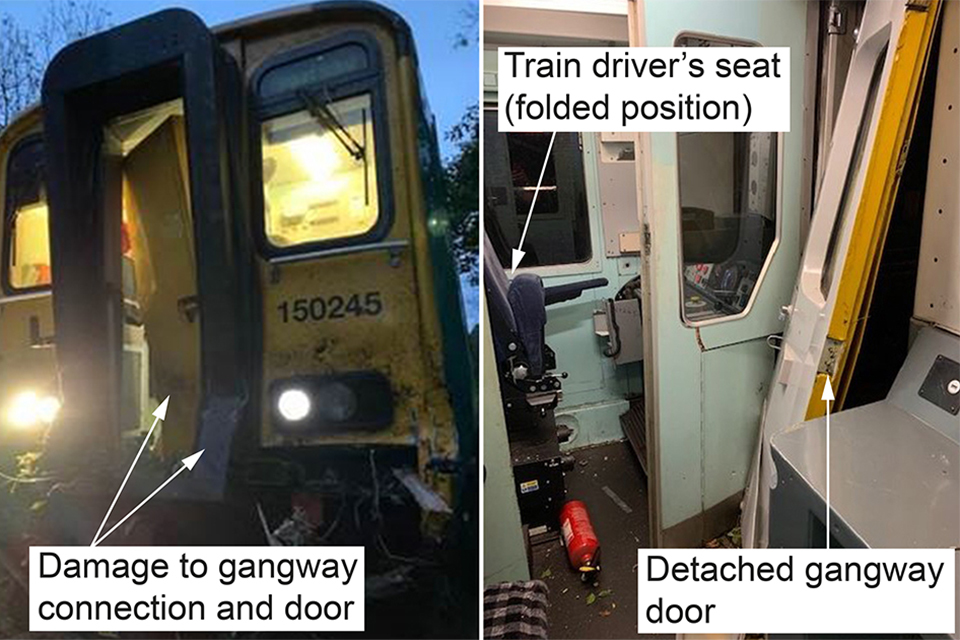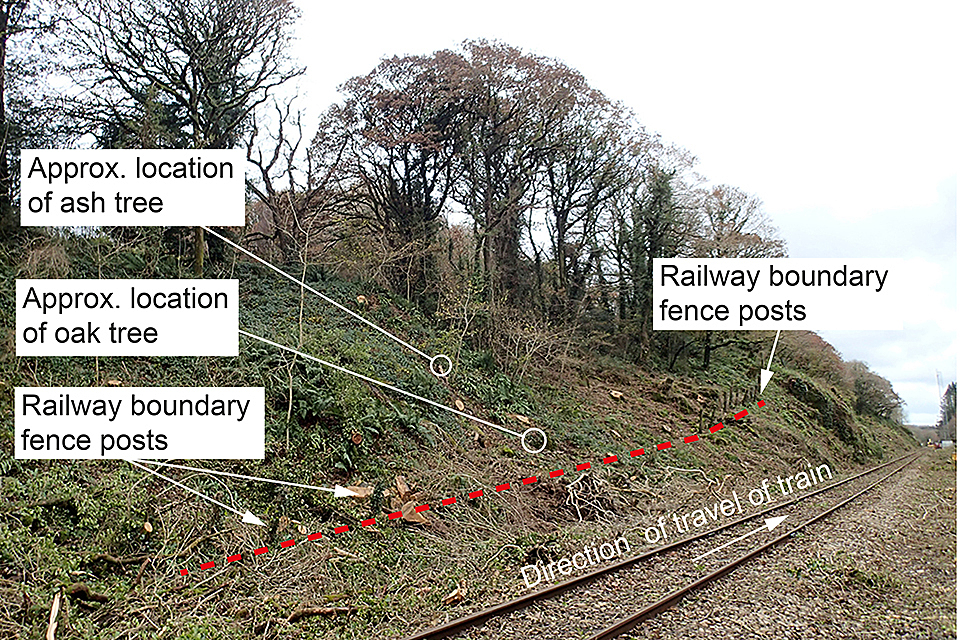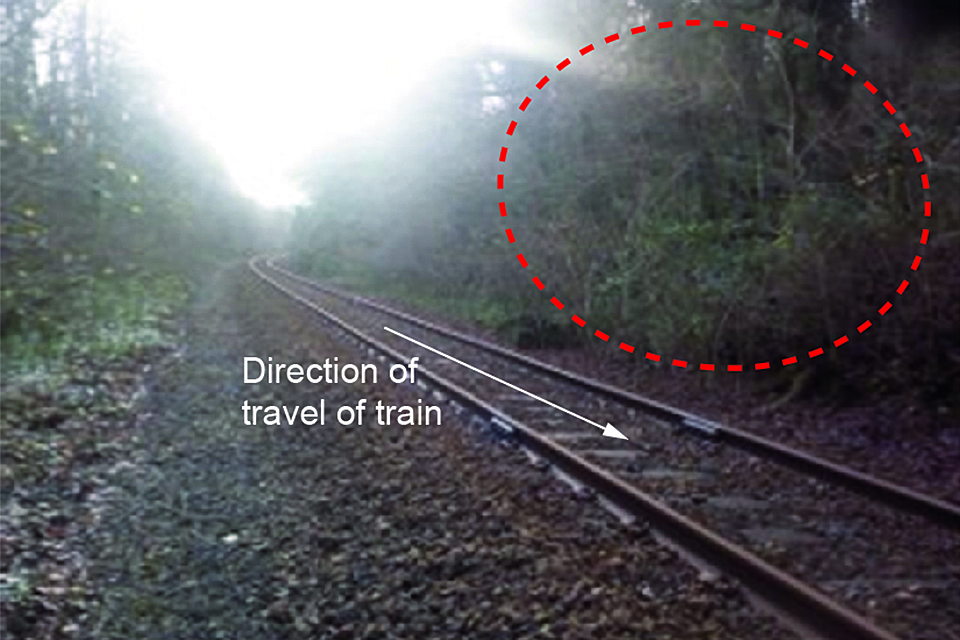Train collision with tree near Spittal, Pembrokeshire, 17 October 2019
Published 18 February 2020
1. Important safety messages
This accident demonstrates the importance of:
- land owners adjacent to the railway inspecting trees on their land and taking appropriate action to ensure that they do not pose a risk to railway safety (Network Rail reported that it intends to publish guidance to land owners on its external website by the end of February 2020)
- railways knowing, where practicable, who owns and occupies neighbouring land where there is a risk of trees falling onto the railway, and providing information to them about the danger to the railway due to falling trees
2. Summary of the accident
At around 18:33 hrs on 17 October 2019, a train carrying 13 passengers and two crew members collided with a large oak tree that had fallen across the railway between the villages of Spittal and Treffgarne, Pembrokeshire. The train was travelling at around 55 mph (89 km/h), the maximum permitted speed at this location, when the collision occurred. Although the train did not derail, the front was badly damaged, and it was unable to continue its journey. The train driver suffered a minor injury and was left shocked by the accident.

Damage to the train front and driving cab area (images courtesy of Network Rail)
3. Cause of the accident
The tree that fell across the railway was an oak tree, estimated to be around 24 metres tall. It had grown around 8 metres from the railway track at a location about 0.4 metres outside the railway boundary fence. It fell because a diseased ash tree had fallen against it. The ash tree was around 21 metres tall and had grown about 12 metres from the railway track and about 4.4 metres outside the railway boundary.
Trees at the site of the accident, including those outside the railway boundary, have shallow root structures because they are growing in shallow soil on a rocky slope. The shallow root structure is the most likely reason that the oak tree fell after being struck by the ash tree.

Location of the oak and ash trees (dashed red line shows railway boundary)
Network Rail, the owner of the railway infrastructure at this location, has procedures requiring inspection of trees within falling distance of its railway tracks. The procedures are intended to identify ‘hazardous trees’. A hazardous tree is defined by Network Rail as ‘a tree, which may have significant defects, that poses a risk to either the railway or a third party’.
Network Rail’s procedures require tree inspections on foot every 36 to 44 months, and from train cabs every 12 to 16 months. The last inspection on foot at the accident site was on 28 June 2017 and the last inspection from a train cab was on 16 October 2019. No hazardous trees were identified during these inspections on Network Rail land or on land beyond the railway boundary. No tree-related inspections were outstanding at the time of the accident.
Although Network Rail procedures required tree inspections to include trees outside the railway boundary, the diseased part of the ash tree was near the ground and was probably not visible from within the railway boundary due to the presence of other vegetation. Access to the bottom of the ash tree would have been difficult due to underfoot conditions and other vegetation. In addition, Network Rail staff are not expected to walk outside the railway boundary when carrying out inspections as they do not have a legal right to enter neighbouring land for this purpose.

Pre-accident image with dashed line showing area from which trees fell (image courtesy of Network Rail)
Network Rail has processes for assessing risk once a hazardous tree has been identified. These consider the number of and types of tree defect, the maximum permitted train speed, the likely size of the part of the tree that could be struck by a train, and the potential consequences, such as train derailment. The actions required as a result of these risk assessments vary from additional inspections, to closing the railway until the hazard has been dealt with. The processes involve contacting neighbouring landowners where necessary. None of these processes were applied at the accident site because no hazardous trees had been identified by Network Rail during its inspections.
Landowners have a common law duty to prevent reasonably foreseeable harm to their neighbour’s property; in this case, the railway. It has not been possible to establish if any person or organisation was aware of the condition of the ash tree before the accident, partly because enquiries by Network Rail have not identified the landowner. The two immediately adjoining landowners have been identified and both state that their boundaries do not include the area of land from which the trees fell.
4. Previous similar occurrence
RAIB report 08/2011 describes an accident in July 2010 in which a train struck a tree that had fallen across the track near the village of Lavington in Wiltshire. The train was travelling at about 92 mph (148 km/h) and, although it did not derail, the driving cab of the train was extensively damaged and the train’s driver sustained minor injuries.
The investigation found that the dangerous condition of the tree had not been identified before the accident. The tree was on land that was not owned by the railway, and the landowner was not conscious of the risk that trees on his land could present to the railway. The investigation also found that Network Rail could not have identified the condition of this tree as it was not visible from within the railway boundary and Network Rail had no legal powers to enter neighbouring land.
The report included recommendations intended to improve the way Network Rail manages risk to the railway from trees on land it does not own, including a recommendation to improve communication with those of its neighbours whose land is considered to present a high risk of tree fall affecting the railway.
On 21 June 2011, Network Rail reported to the Office of Rail and Road that one of the actions it intended to take in response to this recommendation was to produce, and put on the ‘managing vegetation’ section of its external website, guidance on ‘the responsibilities of landowners and the potential risks that trees can present to the railway’.
Following the accident near Spittal on 17 October 2019, RAIB found that although Network Rail had taken some actions in response to recommendations arising from the RAIB‘s Lavington investigation, this guidance had not been put on its external website. Network Rail stated that it has been unable to determine if the guidance had ever been included on its external website as originally intended, or if it had been included but was later removed for an unknown reason. Network Rail reported to RAIB that it intends to update its external website with the guidance by the end of February 2020.

